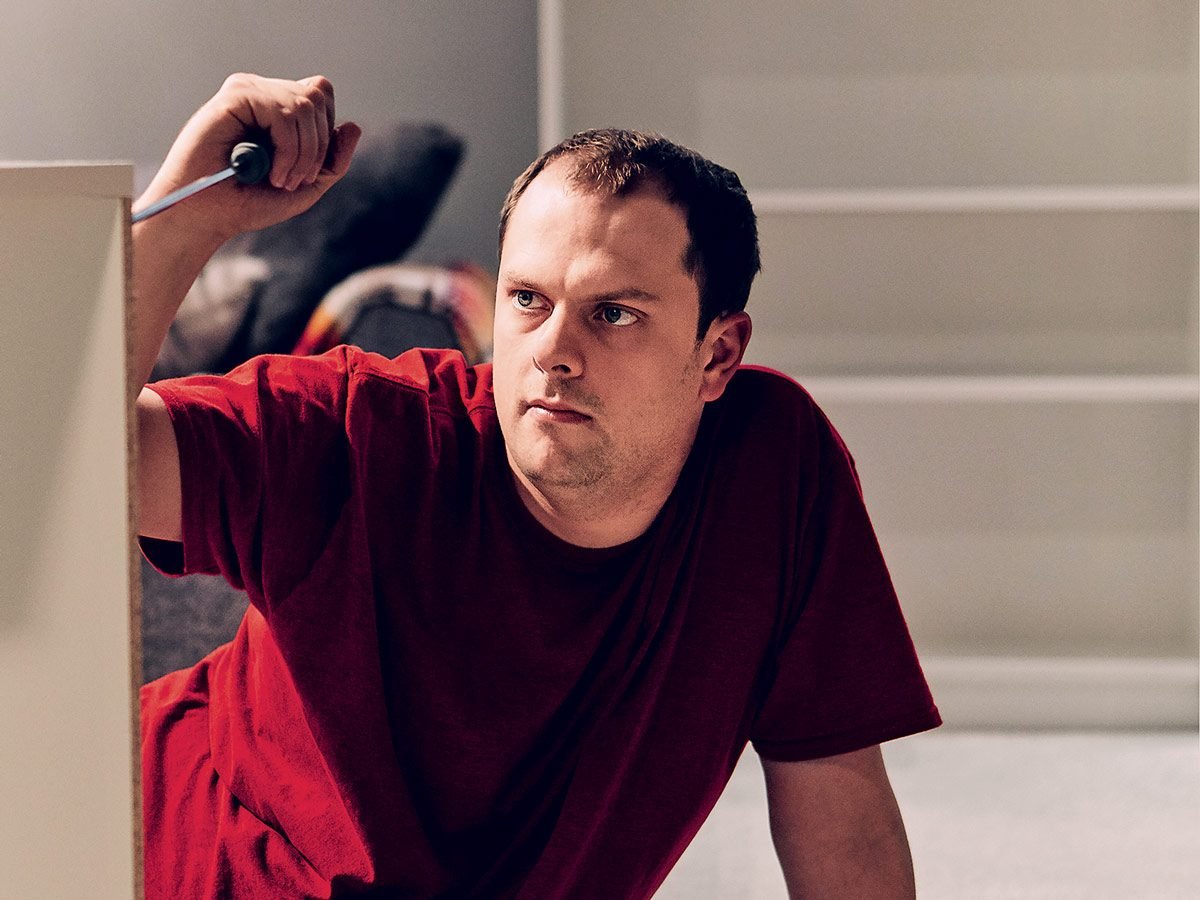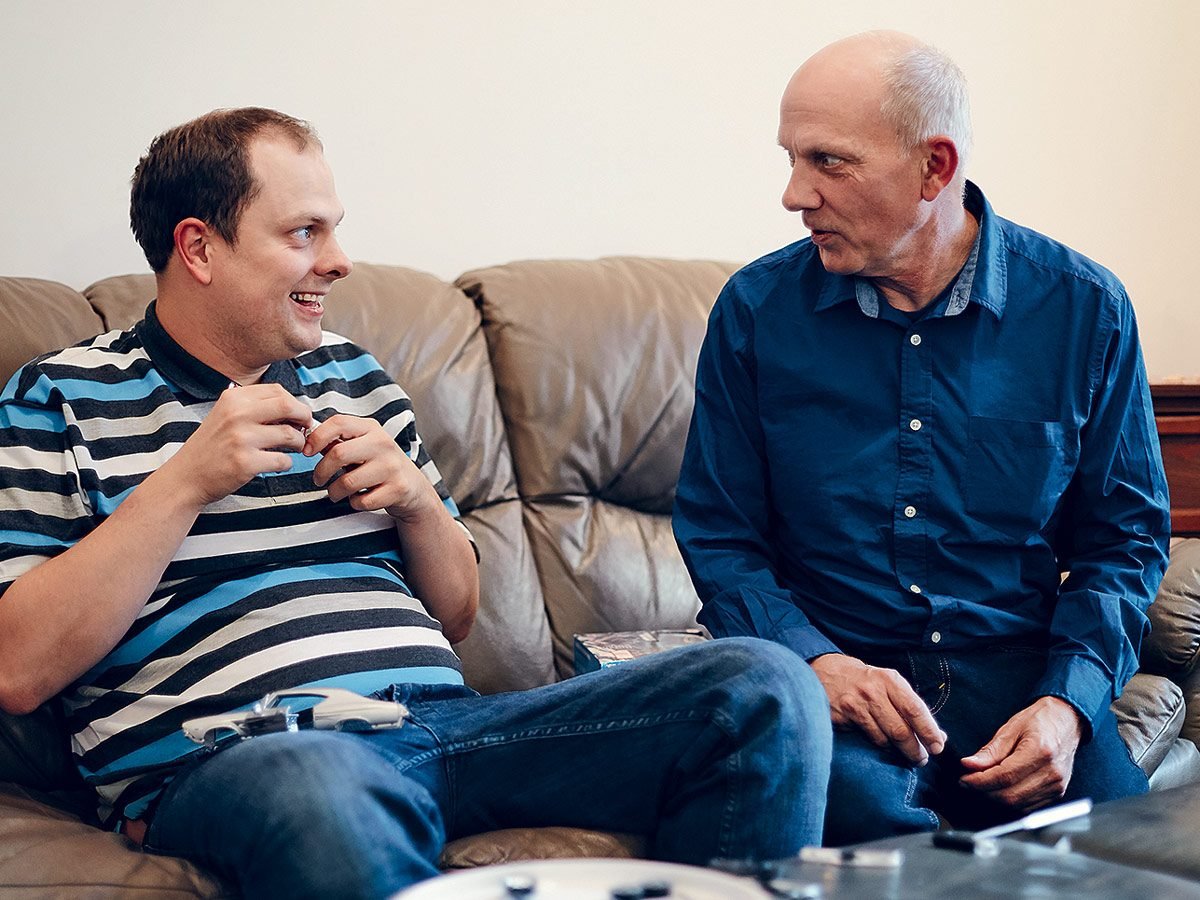
Brad can build anything
Brad Fremmerlid walks into a client’s house in northeastern Edmonton on a cold Friday morning in January, 2019, and heads straight downstairs. He’s 30 years old, tall, with bright-blue eyes and strawberry-blond hair. He likes skating and making music, but it’s his work that has changed his life.
In his client’s newly renovated basement, Fremmerlid opens a box containing an Erik filing cabinet from IKEA and spreads 25 pieces and 16 screws around him on the floor. He stares at the ceiling. He paces to the bathroom. He spins repeatedly through the hallway, nearly hitting his head on the ceiling. He groans and hums.
The booklet of assembly instructions sits unopened nearby.
“And he can do this?” his client asks, somewhat tentatively.
“Oh yes,” says Herbie Almonia, a community support worker who has gone with Fremmerlid to hundreds such jobs. “Brad can put together anything.”
Fremmerlid lives with severe autism. He can’t read, write or communicate outside a few sign language gestures. He can’t navigate finding a public bathroom. He can’t cross a street alone.
But through his work, Fremmerlid has become an inspiration for people around the world, and especially families of others with autism.
“There is hope,” his mother, Deb Fremmerlid, says. “Even when you don’t think there is.”
As a child, Fremmerlid seemed to his parents to be in his own world, an “unguided missile” moving through their lives, unreachable, unstoppable. He would get up early and stay up late, fuelled by a wild energy that could only be contained if he was kept constantly busy—and otherwise left him unmanageable and screaming, sometimes violent. He was diagnosed with pervasive developmental disorder as a toddler, and later, with autism.
“I put almost all my energy into trying to change Brad,” his father, Mark Fremmerlid, remembers.
For years, the couple tried desperately to make a connection with their son, but nothing seemed to work. At worst, Mark says, it seemed like failure. At best, it felt as if they were only coping.
Experts want you to know these important facts about autism.
A hobby becomes a business
But while Fremmerlid struggled in many areas, he also had great strengths. In particular, Mark noticed how easily his son could put things together, as though his brain naturally understood how a series of pieces could be assembled into something whole.
In Fremmerlid’s teen years, he and his dad started building: complex die-cast cars, model airplanes, furniture, Lego sets with hundreds of pieces and instruction books as thick as novels. No matter the challenge, Fremmerlid could do it, often without even looking at the instructions.
“That’s what he does,” Mark says. “He puts things into order.”
In 2012, Mark got the idea for a business in part because Brad could build so much, so fast, that it was impossible to keep buying him new projects. Fremmerlid built almost every piece of furniture in their home, and his models and Lego kits collected in a room in the basement.
But Mark thought about how companies such as IKEA sell so much that has to be assembled, and how many people dislike putting their products together or find it difficult. He knew that, with support, Fremmerlid could perform a valuable service while interacting with the world in a way that was positive and productive.
When an online ad on Kijiji yielded only two responses, Mark started working with an Edmonton think tank that had experience developing programming for people with disabilities.
Together, they figured out a plan for a business, Made By Brad, and in 2013 produced a video that showed people who Fremmerlid was and what he could do. The video went up on YouTube, and soon Mark started to get messages from people who wanted to hire his son.
At work, as in all other parts of Fremmerlid’s life, there is an unchangeable routine. At his client’s house, Fremmerlid drinks water, eats dry cereal, has an apple. Then he packs up his garbage and visits the washroom for the first of what will be three visits.
His behaviour can seem disconcerting to clients, so Almonia sits nearby, explaining the routines, the things Fremmerlid is doing and why.
Though one reviewer on IKEA’s website specifically criticized the Erik filing cabinet as “very difficult to assemble,” it’s easy for Fremmerlid to figure out—and he’s completed much harder projects. He doesn’t even open the instruction book, but silently surveys the pieces around him, calculating where they go.
“There is no day that this guy doesn’t amaze me,” Almonia says. “I just watch him in awe.”
When the homeowner picks up the manual out of curiosity, Fremmerlid takes it from her hands and puts it aside. Although he can’t communicate, his meaning is clear. I know what to do.
And he does. The cabinet comes together, solid and perfectly assembled. Fremmerlid tries the drawers and the lock, and he’s finished.
“I don’t even check it anymore,” Almonia tells the client. “He puts it together, and it’s always right.”
So far, Fremmerlid has done more than 1,000 jobs. He’s assembled wardrobes and dressers and bookshelves, gazebos and closet systems and entire kitchens. There hasn’t been a job he couldn’t do.
“It’s quite common that I won’t understand and he will,” says Mark, a pilot. “As far as putting things together, he’s the best.”
These heartwarming stories will restore your faith in humanity.

Learning on the job
From his jobs, Fremmerlid earns about $400 a month, which is allowed under the funding he receives from Alberta’s Assured Income for the Severely Handicapped. A portion helps pay for sign-language lessons at his group home and contributes to the purchase of his models and kits, and the rest is saved for Fremmerlid. Most jobs range between $25 and $40, but the work is more valuable than the money, and Mark tries to make sure there are always jobs coming in.
Fremmerlid slips easily into routines that can become oppressive. If he does something the same way a couple of times, it may have to be that way forever, and any change can prompt an explosive reaction. But the jobs are, by nature, different. Each one a new challenge, a new environment, new people.
His parents say he makes more eye contact now, and is more attentive to things and people around him. Fremmerlid used to be afraid of animals, but now that he’s sometimes around them at work, he’s started to like cats, while dogs don’t scare him as much as they once did. Away from work, he’s happier, too. He no longer punches holes in the walls of his group home, and he doesn’t hit himself like he used to. There hasn’t been a serious incident in more than a year.
“It’s like he’s had 1,000 different therapists,” Mark says of Fremmerlid’s clients. Each one teaching him something, making him more adaptable, more social, building up his confidence and his skill. Sometimes while he’s working he smiles and smirks, obviously proud of what he’s doing, and enjoying the people around him marvelling at his skill.
Fremmerlid is also developing in ways his parents did not expect. As he enters his thirties, he’s learned to identify some colours, and Mark figured out how to teach Fremmerlid math operations with fill-in-the-blank equations on a children’s calculator app.
5 x _ = 35
8 x _= 72
54 + _= 75
Fremmerlid stares at each one for a moment before entering his answers. He’s right every time.
“I was always so desperate every day when he was young, because I thought the learning window was so narrow,” Mark says. “But it didn’t turn out to be true.”
In February 2019, a week after his job putting together the Erik filing cabinet, Fremmerlid and his dad go through their evening routine. They skate, make snacks, shave together, eat dinner. Fremmerlid makes a Lego kit, does some math problems, a colouring page.
It’s a long way from where he has been, including the group home where Fremmerlid, at age 16, broke a window and was tackled by four men and sedated—and was later guarded by security at the hospital. “All he needs is something to do,” Mark pleaded with the nurses then, and he wrote sentences on a piece of paper so his son could copy the shapes.
Fremmerlid’s parents fought to get him into a day program, believing every person has a right to leave their house and be out in the world. They fight for his work, believing every person has a right to do something meaningful.
The Made By Brad video continues to circulate on social media, and Mark shares Fremmerlid’s jobs and progress on Facebook, where supporters cheer his accomplishments. Mark says people contact him regularly, encouraged by what Fremmerlid has been able to do, and by the thought of what their own children with autism could maybe achieve as well.
Mark says his son’s success has inspired him, too.
“I thought having an autistic child was the worst thing that could happen,” he says. “And now I would say, ‘Well, actually it’s the best, for me.’ It’s amazing what he’s done for me.”
Next, read about the courier service employing Canadians with intellectual disabilities.
From “Brad Can Put Together Anything,” by Jana G. Pruden, The Globe and Mail, (April 17, 2019), theglobeandmail.com.